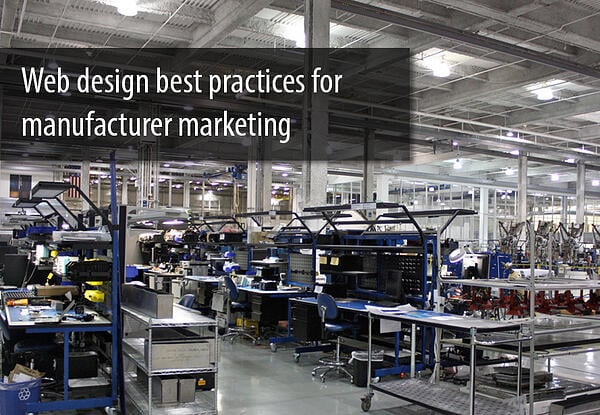What Do the Best Manufacturing Websites Have in Common?

If you've ever been involved in designing a new website, or website redesign, for a manufacturing business, you've probably tried to address the question of what the website needs to do.
This starts with knowing your audience and possible answers include to give some background on your company, its story, values, expertise, showcase your products, educate prospects on the application of your products and how they solve your customers challenges, give proof of your expertise with case studies, and anything else that will compel qualified prospects to want to know more.
After covering the basic website requirements, what do the best manufacturing websites do? We've gone through the list of 2014 Webawards for manufacturing to see what the winners have in common. We believe that if you include these elements, your site will also be a winner, at least from a prospective customer's perspective.
Elements of a Great Website for a Manufacturing Business:
If you want to better understand how to redesign a website, here are some of the elements that all of the winning manufacturing websites had in common:
1. Mobile Responsiveness
A responsive website means that if you are viewing the site on a phone or tablet, you don't need to manually re-size the page to be able to read it. About 50% of web searches start on a mobile device, so you want to make sure your site is easy for those readers to view and use.
Even more importantly, as of April 21, 2015, Google will factor mobile responsiveness into its algorithmn. So if your site is not responsive, you're going to have a tough time being found by prospective customers.
2. Good User Experience (UX)
When a visitor has a good user experience on a website, they are more likely to stay on the site longer, as well as reference it again in the future. Good UX design means your visitor can find what they're looking for in as few as clicks as possible.
Our job as marketers is to find qualified leads (or have them find us!) so we want leads to be able to quickly identify something on the homepage that lets them know they're in the right place for what they need.
If we use one of the winners, Bruce.com, a hardwood flooring company, as an example, we can see that most visitors can find what they're looking for in one or two clicks. The main menu options include:
- Products - which can be viewed by Product type (Hardwood or Laminate), Color, Look (distressed, traditional, etc) and DIY Installation Level (Beginner or Experienced).
- Why Bruce - reasons as to why you would want to buy from them as opposed to their competitors. This includes their company story, sustainability, awards they've one and product reviews.
- Getting Started - what you need to know before you make a buying decision. Information that educates their customers so they can make a more informed decision.
- Where to Buy - find a store near you
- Support - information on installation, warranties, care, FAQs, glossary of terminology, and more flooring articles
One of the other winners, Praxair, has a section on their homepage dedicated to recruiting, explaining why they're a good place to work. Employer branding like this is an especially great strategy for any company seeking STEM talent.
Design your site map with this in mind so that your leads will be able to determine that they are in the right place to solve their challenge by what's on your homepage.
3. High Quality Images & Video
These are really essential ingredients of any website today. If you look at the website of one of the winners, Diablo Precision, Inc, a precision machining company, you can see how captivating the photo on their homepage looks. It shows one of their machines in action and almost looks like special effects. Another winner, Eaton Steel, has a loop video playing as the backdrop on their homepage.
And many good manufacturing websites, like ididit Inc, are using video to show the application of their products because visitors will spend 100% more time on webpages with video.
4. Website Content
Many of the winners, such as Nikon or Fischer Connectors, use content or inbound marketing to make their site a valuable resource for visitors and keep people coming back.
Some examples include videos, which demonstrate the application or installation of a product, or a blog introducing new products or helping solve customer challenges.
Content is a key part of any SEO strategy, it helps establish credibility and expertise, and it educates prospects as well as existing customers so they can become super users of your product and loyal fans of your company.
Inbound marketing is a more comprehensive application of content marketing and the benefits are significant. Here is a good article to help determine whether inbound is a good fit for your business.
5. Web Analytics
To measure a website's performance, and have the ability to continually improve it, you need website traffic analytics. They tell you how many visitors have been to your site, where the traffic is coming from, how long visitors are staying on your website, what pages they're viewing, etc.
Google analytics code is one of the most common tracking applications, or if you using marketing automation software, the analytics will be included in that. Having the analytics, and reviewing it, is an important part of any marketing plan.
CONCLUSION:
Once you've got the website you believe will attract new visitors and convert them into qualified leads, it's time to make a plan to drive traffic to your site so it will get found by the right traffic. That's where inbound marketing comes into play.
The greatest websites look good and they convert visitors into leads 24/7, becoming your online lead generation machine. Great websites become extremely valuable assets when they are backed up by a marketing strategy that will generate leads
Image by Bruno Sanchez-Andrade Nuño via flickr, licensed under CC by 2.0
Share this
You May Also Like
These Related Stories

How Can I Get More Home Buyers to Visit My Website?

The Inbound Marketing Framework for Repeatable, Measurable Results


/Accreditations/CRM-Implementation-Accredited-Badges.png?width=170&height=138&name=CRM-Implementation-Accredited-Badges.png)
/Accreditations/Onboarding-Accredited-Badges.png?width=170&height=137&name=Onboarding-Accredited-Badges.png)
/Accreditations/Custom-Integration-Accredited-Badges.png?width=170&height=137&name=Custom-Integration-Accredited-Badges.png)

